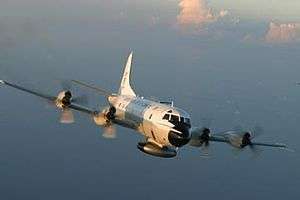Lockheed WP-3D Orion
| WP-3D Orion | |
|---|---|
 | |
| NOAA Lockheed WP-3D Hurricane Hunters | |
| Role | Weather reconnaissance aircraft |
| National origin | United States |
| Manufacturer | Lockheed |
| First flight | 1975 |
| Introduction | 1976 |
| Primary user | National Oceanic and Atmospheric Administration |
| Number built | 2 |
| Developed from | P-3C Orion |

The Lockheed WP-3D Orion is a highly modified P-3 Orion used by the Aircraft Operations Center division of the National Oceanic and Atmospheric Administration (NOAA). Only two of these aircraft exist, each incorporating numerous features for the role of collecting weather information. During hurricane season, the WP-3Ds are deployed for duty as hurricane hunters. The aircraft also support research on other topics, such as Arctic ice coverage, air chemistry studies, and ocean water temperature and current analysis.[1]
The WP-3Ds are equipped with three weather radars, C band radars in the nose and on the lower fuselage, and an X-band radar in the aircraft's tail. They are also equipped with the ability to deploy dropsondes into storm systems, and have onboard temperature sensors, and other meteorological equipment. The aircraft are not specially strengthened for flying into hurricanes, however their decks were reinforced to withstand the additional equipment load.
It has two barber-pole samplers (named for their red-and-white stripes) which protrude from the aircraft’s front, a tail Doppler weather radar, and other unique-looking instruments hanging from the wing.[2]
NOAA currently operates two WP-3Ds nicknamed Miss Piggy and Kermit, and their logos featuring the characters created by Jim Henson Productions. NOAA's other hurricane hunting aircraft, the Gulfstream IV-SP, is named Gonzo; they complement the fleet of WC-130 aircraft operated by the U.S. Air Force 53rd Weather Reconnaissance Squadron. As of 2014, the two Orions had each flown more than 10,000 hours and flown into more than 80 hurricanes.[1]
During 2015 to 2017 the aircraft will receive major overhauls, costing a total of $35 million. This work is being performed by the US Navy, Fleet Readiness Center SE in Jacksonville Florida. The work includes new wings and engines and upgraded radars and avionics. NOAA anticipates that these changes will allow the aircraft to fly for another 15-20 years.[1]
Specifications (P-3 Orion)
General characteristics
- Crew: 11
- Length: 116 ft 10 in (35.6 m)
- Wingspan: 99 ft 8 in (30.4 m)
- Height: 33 ft 8.5 in (10.3 m)
- Wing area: 1300 ft² (120.8 m²)
- Empty weight: 61,500 lb (27,900 kg)
- Loaded weight: lb (kg)
- Max. takeoff weight: 139,760 lb (63,400 kg)
- Powerplant: 4 × Allison T56-A-14 turboprop, 4,600 shp (3,700 kW) each
Performance
- Maximum speed: 466 mph (745 km/h)
- Range: 2,700 miles combat / 5,600 miles ferry (4,400 km / 9,000 km)
- Service ceiling: 28,300 ft (8,600 m)
- Rate of climb: 3,140 ft/min (957 m/min)
- Wing loading: 107 lb/ft² (530 kg/m²)
- Power/mass: 0.3 hp/lb (0.06 kW/kg)
See also
- Related development
- Aircraft of comparable role, configuration and era
- Lockheed WC-130
- Convair 580 - National Research Council (Canada) converted to perform atmospheric testing
- Related lists
Notes
- 1 2 3 Altman, Howard (August 14, 2014). "MacDill hurricane hunters to get $35 million overhaul". The Tampa Tribune. Retrieved May 6, 2016.
- ↑ Krohn, Dennis (March 2008). "USGS Extreme Storm Team Receives Christmas Week Tour of NOAA Aircraft Facility". Retrieved December 14, 2010.
External links
| Wikimedia Commons has media related to WP-3 Hurricane Hunter. |